
Pat Tillman's legacy carried on by the good deeds of the people he touched in life
9/11/2011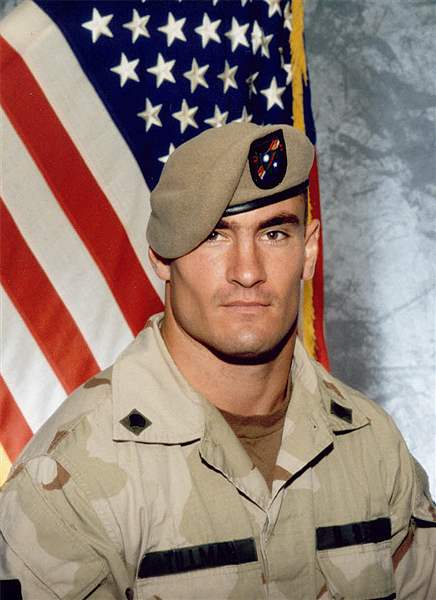
A standout safety with the Arizona Cardinals, Cpl. Pat Tillman became a national symbol when he left behind a huge contract and a newlywed bride to join the Army eight months after the Sept. 11, 2001, terrorist attacks. His death three years later in the mountains of Afghanistan hit the country like a sucker punch and it only got worse when it was revealed he had been killed by friendly fire.
AP/Photography Plus
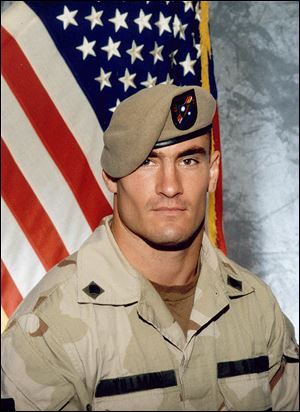
A standout safety with the Arizona Cardinals, Cpl. Pat Tillman became a national symbol when he left behind a huge contract and a newlywed bride to join the Army eight months after the Sept. 11, 2001, terrorist attacks. His death three years later in the mountains of Afghanistan hit the country like a sucker punch and it only got worse when it was revealed he had been killed by friendly fire.
TEMPE, Ariz. — The south steps of Arizona State's football stadium became a shrine in the days after Pat Tillman's death, covered in flags and flowers, signs and mementos.
Tributes to the NFL star-turned-soldier continued to pop up across the country in the weeks and months that followed — stadiums, street signs, awards, even children named in his honor. More substantial memorials came in subsequent years: a statue outside Arizona's NFL stadium, a bridge high above the massive Hoover Dam, a veteran's center at the Arizona State University.
For all that brick and bronze, no monument captures his spirit. That's carried on through the good deeds and stunning accomplishments of the thousands he inspired.
This is their story — the story of what Pat Tillman left behind.
"People reacted emotionally across the country and around the world about his decision to leave football and join the Army, and then when he was killed it had a profound impact on people," said Marie Tillman, Pat's widow. "It's great to hear (what people have done in his name) because it is the lasting legacy he leaves."
A standout safety with the Arizona Cardinals, Tillman became a national symbol when he left behind a huge contract and a new bride to join the Army eight months after the Sept. 11, 2001, terrorist attacks.
His death three years later in the mountains of Afghanistan hit the country like a sucker punch and it only got worse when it was revealed he had been killed by friendly fire. Later, a flurry of outrage followed when the Tillman family helped uncover misleading statements and actions by the U.S. government surrounding Pat's death.
The headline characterizations of Tillman were simple: athlete, patriot, war hero and, for some, martyr. But Tillman was more than that.
Those close to him remember an unpretentious guy, determined and thoughtful, yet inspiring, too. To them, his legacy isn't simply a pump-up, something to make people feel good about themselves. It's a call to action.
In the seven years since his death, those who knew or met Tillman, and even people who only heard his story, have been pushed past their comfort levels to do things they never thought they could.
"He was just one of those guys who was in the moment and people connect with that," said Marcy Wojtulewicz, deputy director of the Pat Tillman Foundation. "He just impacts you."
___
The hot desert sun reduced to slivers by the living room blinds, Sheldon Davidson quietly weeps in his wheelchair.
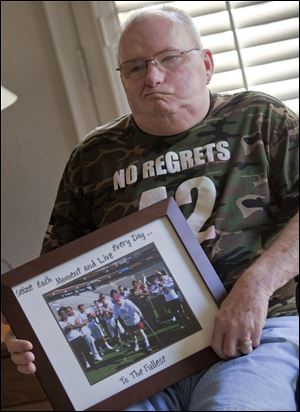
Sheldon Davidson holds a photograph of his first Pat's Run marathon in 2009 at his home in Mesa, Ariz. The 60-year-old war veteran described his first attempt at Pat’s Run after suffering a stroke is overcome with emotion as he recalls how the memory of Tillman pushed him to the finish line when his body was seemingly unable to go on.
Describing his first attempt at Pat's Run after suffering a stroke, the 60-year-old war veteran is overcome with emotion as he recalls how the memory of Tillman pushed him to the finish line when his body felt like it couldn't go on.
"Pat used to climb up to the light tower to think and I pictured him up there, watching over me," Davidson said at his home in Mesa. "I felt like he was up there watching over me and that's what kept me going. I wasn't going to stop."
Pat's Run started as gathering of friends and family who wanted to celebrate Tillman's life not long after his death. The 4.2-mile run has since ballooned into a massive event of 30,000 runners from all over the country — 49 states this past spring — hitting the desert to honor the man and raise money for the foundation in his name.
A fan of Tillman's when he played at Arizona State and later with the Cardinals — he once shook Tillman's hand and said "good game" at ASU — Davidson was an enthusiastic Pat's Run participant the first two years, enjoying the chance to pay tribute to someone he respected.
Then, in 2007, he suffered a stroke.
Doctors said he'd never walk again, never be free of a catheter. They weren't sure if he'd ever regain his sight.
The man they call Shelly proved them wrong.
Months after his stroke, Davidson, not wanting to miss the race, was pushed around the course by his daughter, Jennifer Goins. A year later, he walked part of the way, using his chair for support.
In 2009, Davidson made even more progress.
Even after struggling through the middle portion of the race, Davidson entered Arizona State's stadium and finished the final 42 yards — in honor of Tillman's ASU jersey number — on foot.
With members of ASU's football team screaming encouragement, Davidson, leaning hard on his crutches, trudged the final few yards and over the finish line. Spectators shed tears. Family and friends did the same when a video of his feat was posted on the Internet.
"I felt like he left the Cardinals to go take care of Osama bin Laden and his journey was cut short, and I wanted to keep just keep going," said Davidson, who spent a year overseas in the Vietnam War during his two active years in the Army. "Even though his was cut short, my journey was to go on and walk and I'm not going to stop until I'm walking."
Davidson plans to do Pat's Run again next year, hopefully without his crutches.
___
The sentences are simple, about what you'd expect from a fourth grader. But even adults would have a hard time summing up how many people feel about Tillman so succinctly.
"Pat Tillman's name should have marked everybody's heart the day he died. Everybody in the world should remember Pat's famous name. He was so inspirational to everyone." -- Justine.
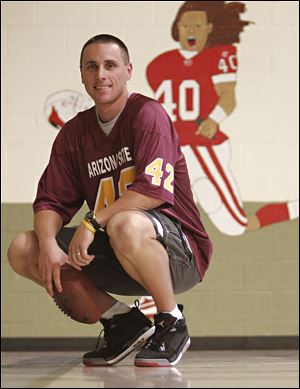
Brian Webster holds a football in front of a painting he made of Pat Tillman in the Pickett Elementary School gymnasium in Queen Creek, Ariz.
The response was just what Brian Webster had in mind when assigned his students to write an essay about Tillman.
A transplant from Philadelphia, Webster didn't know much about the former football player until he moved to Arizona with his wife — an Arizona State student while Tillman was there — and witnessed the immense sorrow that the entire state felt when he was killed.
Enamored by the man and the decisions he made, Webster decided to join Pat's Run and hasn't missed one, doing all seven with his son.
But Webster wanted to do more to keep Tillman's spirit alive, so when he had to come up with a state-required written lesson plan, the physical education teacher asked his students at Pickett Elementary School in Queen Creek to write an essay about Tillman.
"The title of the paper is 'Remember his Name,' so 10-15 years from now, when they hear the name Pat Tillman, I want them to remember the name," said Webster, who also drew a portrait of Tillman on the gym wall. "I don't want him to disappear over time, for people to forget him."
For the essay, Webster has the students watch a biography video on Tillman and sends them home with information to read about him. He outlines what he wants in each of the five paragraphs and doesn't require them to agree with his assertion that Tillman was a positive role model, asking only that they back up any statements they make about him.
The students have a week to write the essay.
In the final paragraph, Webster asks the students to come up with a way they can have a positive influence on people's lives. It's his favorite part, especially when students turn in material like this:
"I can make a positive difference in the live(s) of others by see(ing) what I have here in front of me and not taking anything for granted. Maybe I could donate some of my things to homeless people and show my kindness and love I have for my family and our WORLD!!" -- Savannah M.
___
Wearing the loose-fitting garb of the locals, with a head wrap and a full beard, grime-covered Sergeant First Class Glen Lacroix had just arrived at a military base in Afghanistan in 2004 when he came across a thick-necked Army Ranger built like a tank.
Immediately recognizing the most famous of Rangers, Lacroix was looking to shake his hand, only to be greeted by the rigid at-attention posture soldiers give to superior officers in battle zones instead of saluting.
Lacroix told the Ranger to relax and the fellow Special Operations soldiers hit it off quickly, spending seven hours talking the night away. Lacroix tried to shift the conversation to football — Tillman was only interested in Lacroix's job in the intelligence world.
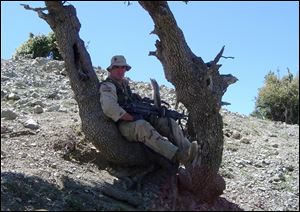
Pat Tillman rests on a tree in Afghanistan.
"Unbelievable guy, awesome dude," Lacroix said from his office at the University of Arizona in Tucson. "It was one of those things where it was what you see is what you get. There was no (nonsense)."
Lacroix is one of 171 Pat Tillman Military Scholars, a program developed by the Pat Tillman Foundation to help servicemen and family members earn degrees or complete certificate programs.
Originally set up to handle the influx of checks being sent to the Tillman family shortly after Pat's death, the PTF expanded a few years later to pledge $1.25 million to the W.P. Carey School of Business at Arizona State. Once that promise was fulfilled, the foundation shifted focus again, this time to help fill the financial gaps in the GI Bill.
PTF has awarded over $4.4 million since its inception seven years ago, $2.2 million going to the Tillman Military Scholars.
Lacroix was a good candidate.
He spent 13 years in the Army, including nine working human intelligence for Special Operations, followed by three more years in civil service intelligence.
Lacroix saw action in some of the most dangerous places in the world, including Iraq, Afghanistan, Bosnia and Kosovo, and spent part of his time as a sniper in war zones. He took shrapnel in Iraq and was shot twice in Afghanistan, including April 22, 2004 — the same day Tillman was killed just 30 miles away. Lacroix also was part of the team that helped rescue Pfc. Jessica Lynch from an Iraqi hospital, a large detail that included Tillman.
Upon returning to school in 2009, four years after receiving a medical discharge, he had a hard time adjusting to campus life, unable to comprehend how the students couldn't follow the simplest of instructions or why the young woman in front of him was crying because she missed her cat while he still had bone fragments of his buddy lodged in his arm.
Ready to walk away, Lacroix instead wandered into the university's Veterans Education and Transition Services, which had opened the semester before.
It was a move that may have saved his life.
"Honestly, the first day I walked in here, if someone would have said no to me or it's going to have to wait, I wouldn't be here," he said. "I'd be in a gutter somewhere drinking away my disability every month."
Taking advantage of his scholarship through the PTF, Lacroix helped the VETS center expand, working as the student director in a place where former military — from Vietnam War veterans to reservists who never saw action — could go to be away from the regular student population, among people like themselves.
An office that saw five veterans a day when it first opened, the VETS center now has 150 or so students filter through daily.
Lacroix plans to keep working at the VETS center while at UA, but has a bigger goal in mind: a former physical therapist aide, he'd like to work at a place where injured soldiers can have their physical and mental wounds healed at the same.
"Every time I got injured, it was always they'd treat body and they'd treat mind, but they'd never treat them both together," said Lacroix, who's majoring in psychology and plans to get his doctorate in physical therapy. "Your injuries come as a whole, so your treatment needs to come as a whole — and that's what I want to do."
___
The day before last year's New York City Marathon, members of Team Tillman had already had some memorable moments, visiting a firehouse and also NFL headquarters, where they saw Commissioner Roger Goodell's office and a tribute to Tillman by the door.
What came next had them ready to run 100 miles, not 26.
Gathering in a meeting room with their families at the NFL offices, the 40 members of Team Tillman took turns recounting their decisions to run the marathon. Some were friends of Tillman's or had stories about him to tell, while others had more personal, heartfelt reasons for wanting to run. For more than two hours they took turns talking and crying.
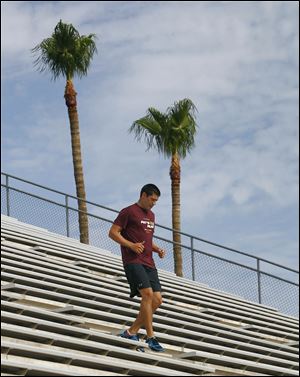
Former Arizona State golfer Pat Moore runs the bleachers at Arizona State University early in Tempe, Ariz.
"I wasn't expecting much, but about five minutes into it, I quickly realized it wasn't really a joking matter," said former Arizona State golfer Pat Moore, who ran his first marathon for Team Tillman last year. "It was a shock; I wasn't expecting that at all. To see grown men get up and start crying was big, very powerful."
Team Tillman started five years ago as a fundraiser for the Pat Tillman Foundation, asking runners to raise at least $4,240 each.
The team has competed in the past four New York City Marathons, along with the MarineCorps Marathon, and has expanded to marathons in Chicago and Washington, D.C. Other athletes, like former baseball player Eric Byrnes, have competed for Team Tillman as individuals in triathlons and other events around the world.
The highlights of the New York City Marathon weekend are usually the stories shared and a trip to see a firehouse near the World Trade Center that was damaged during the Sept. 11 attacks. Last year, the group also went to a firehouse in Brooklyn.
"There's not a lot of dry eyes," said Ryan Cronk, a real estate developer from Indianapolis who will run in his fifth straight New York Marathon for Team Tillman this year despite having no prior ties to Tillman. "Some people's stories are more personal, some completely revolve around Pat and everyone runs for different reasons, but they're all running for the same cause: the foundation and veterans."
A new member of Team Tillman at last year's race was ESPN "SportsCenter" anchor John Anderson.
Anderson worked in Arizona during Tillman's final two seasons at ASU and his rookie year with the Cardinals, and while they didn't go beyond the usual media-athlete relationship, he could see Tillman was different.
A high jumper in college, Anderson had vowed to his wife that he'd never run a marathon. Once the PTF people came calling, he never gave it a second thought.
"Pat inspired people like that, drew people to him and had a way of making people want to be their best," Anderson said. "That, having known him a little, wasn't necessarily tied to the tragic circumstances of death and war. Here was a guy who was just a compelling guy and you would do well to emulate him in those kinds of endeavors."
All 40 Team Tillman members who entered the NYC Marathon last year finished the race, including 300-pound Vito Forlano of Boston, who sprained his ankle five minutes in and still kept going. He completed the marathon in 6 hours, 41 minutes, 50 seconds.
___
Trying to find a comfortable position in the lobby at Cedars-Sinai Medical Center, Samson Szakacsy began to notice that some of the same families were coming through day after day. Recognizing the familiar look of sorrow on their faces as he spent more than 100 days at the hospital himself, he began to talk to them, listening to their stories, the grief they felt for their loved ones.
And, as he listened, Szakacsy instinctively started comforting them, providing words of encouragement, perspective on the big picture of life and what comes after it.
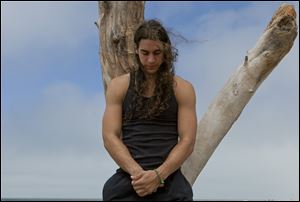
Former Arizona State University football player Samson Szakacsy walked away from football to pursue other interests, including a band he started.
His 17-year-old sister was dying of congestive heart failure upstairs, but Szakacsy pushed aside his own heartache to make sure those around him — complete strangers — were doing OK, letting them know they weren't alone.
"It was sort of a lifestyle, which was beautiful," he said of being in the hospital every day. "In all that pain, people really did come together and support each other. At the root, we're going through the same thing and comforting them comforted me. The best way to heal yourself is to heal others."
Szakacsy was a Tillman Scholar at Arizona State before graduating with a degree in religious studies this year.
Upbeat, introspective, focused on life's big questions, he's more like a Tillman kindred spirit than a Tillman scholar.
An athlete, philosopher and musician, Szakacsy doesn't see life as something to wander through. It's more of a pursuit of greatness, which, to him, means getting joy by giving it to others.
"At the core, Pat brought out the best in people and to bring out the best part of people, you have to address the best part of people and hold people up," Szakacsy said. "Even as you're doing that, you have to be aware of yourself, you have to know yourself. I feel like where I parallel Pat and even people like Christ and Ghandi, they were people who really knew themselves. We're all connected in this thing and when you know you are, you know who everyone is."
Szakacsy's awareness allowed him to make a difficult decision: Like Tillman, he walked away from his athletic career.
With a year of eligibility left, he decided to pass up playing for Arizona State's football team this season to pursue other interests. He was stuck as the third-string quarterback after having two shoulder surgeries and wanted to focus energy on his music, on immersing himself in other cultures and on helping others, particularly the impoverished people of the Apache reservation, whom he had grown close to since being introduced the chief last year.
The news came as no surprise to those who know him.
"I admire guys who say 'I don't want to play anymore because I want to go and do this', guys that you know that decision is thought about for a very long time," Arizona State coach Dennis Erickson said. "I know Sam's thought about that before he made that decision. He's an amazing, amazing person."
Szakacsy's outlook has helped him, and his family, cope with the death his sister.
A vibrant teenager, Hannah developed an infection this spring that turned into congestive heart failure. Despite numerous surgeries that left her scarred all over, she died on July 30, devastating Samson but giving him yet an even deeper understanding of life.
"To me, it was a gift — a painful gift, but a gift nonetheless," Szakacsy said. "That's the way I am living. It's still hard, it's still human, it's still fresh, it's still pain, but everything will be OK."
___
In life, those close to Tillman say he never accepted acceptable. He constantly pushed the boundaries, physically and mentally, always looking for a way better himself. He also expected the same effort from his friends, family, even people he had just met, never letting them just skate by when he was around.
Now, in death, Tillman still has that do-your-best influence over people, is still driving them to strive for more.
"He didn't necessarily encourage people verbally, but through the way he lived his life," said Marie Tillman, who lives in Chicago and will release a memoir next June. "For the people around him, his friends and family, the people he encountered throughout his football career, he had such a drive, such a desire to improve himself that people just sort of saw that and just wanted to be the same way."
Tillman was 27 when he died. His spirit carries on in those he touched.
___
Online: Pat Tillman Foundation